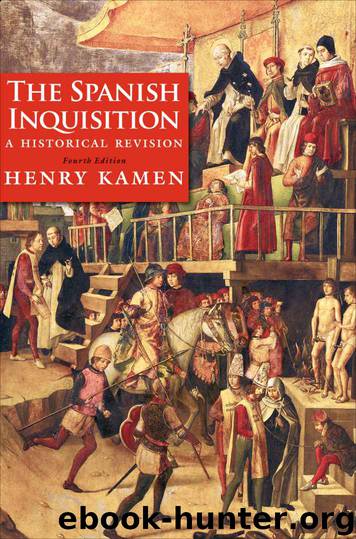The Spanish Inquisition by Henry Kamen

Author:Henry Kamen [Kamen, Henry]
Language: eng
Format: epub, mobi
Publisher: Yale University Press
Published: 2014-05-27T00:00:00+00:00
Graph 1. Prosecutions in the tribunal of Toledo, 1483–1700.
The number of acquittals, though few, was an improvement on the medieval tribunal, which as a rule never acquitted. In its first cases in 1483–85 in Ciudad Real, the inquisitors set free several accused, among them the converso cobbler Diego López, accused of judaizing: “we absolve him, declare him free and acquitted, and reaffirm his good reputation.”90 Outright acquittal, however, meant admitting an error, so it was also common to suspend cases, which was not necessarily a good thing, for it left one technically under suspicion and meant that the prosecution could at any time be renewed. There was only a limited chance of appeal. In cases that ended in a public auto de fe, this was because the accused were not informed of their sentence until they were in the actual procession during the auto; by then it was too late to appeal. The delay in delivering a verdict would naturally heighten the suspense, fear and despair felt by prisoners. But when a man was sentenced to be relaxed he was always informed of his fate the night before the ceremony to give him time in which to prepare his soul for confession and repentance. Later in the history of the tribunal this information was given as much as three days in advance. In private autos there was much more opportunity to appeal after the sentence had been read out. In such cases the appeal always went to the Suprema, appeals to Rome not being encouraged.
Doing penance was the least of the punishments imposed. Those who did penance had to “abjure” their offenses: de levi for a lesser offense, de vehementi for a graver one. The penitent swore to avoid his sin in the future, and if he swore de vehementi, any relapse made him liable to severe punishment on the next occasion.
Penitents were then condemned to physical penalties such as the sanbenito, fines, banishment or sometimes the galleys. “Reconciliation” was in theory the return of a sinner to the bosom of the Church after due spiritual penance had been performed. In practice it was the most severe punishment the Inquisition could inflict, short of relaxation. All the penalties were heavier: in addition to the sanbenito, accused persons could be condemned to flogging and to long spells in prison or the galleys. In most cases confiscation of goods occurred, so that even if a prisoner escaped with a prison sentence of a few months, he came out an orthodox Catholic indeed but facing a life of beggary. An additional rule, frequently enforced, was that anyone backsliding after reconciliation was to be treated as a relapsed heretic and sent to the stake.
The sanbenito, a corrupt form of the words saco bendito (sackcloth of repentance, a garment long in use in the Church),91 was a penitential garment used in the medieval Inquisition and taken over by the Spanish one.92 It was usually a yellow garment with one or two diagonal crosses imposed on
Download
This site does not store any files on its server. We only index and link to content provided by other sites. Please contact the content providers to delete copyright contents if any and email us, we'll remove relevant links or contents immediately.
| Buddhism | Christianity |
| Ethnic & Tribal | General |
| Hinduism | Islam |
| Judaism | New Age, Mythology & Occult |
| Religion, Politics & State |
Cecilia; Or, Memoirs of an Heiress — Volume 1 by Fanny Burney(31340)
Cecilia; Or, Memoirs of an Heiress — Volume 3 by Fanny Burney(30938)
Cecilia; Or, Memoirs of an Heiress — Volume 2 by Fanny Burney(30894)
The Secret History by Donna Tartt(16641)
Sapiens: A Brief History of Humankind by Yuval Noah Harari(13066)
Leonardo da Vinci by Walter Isaacson(11912)
The Radium Girls by Kate Moore(10914)
Sapiens by Yuval Noah Harari(4544)
The Wind in My Hair by Masih Alinejad(4427)
How Democracies Die by Steven Levitsky & Daniel Ziblatt(4406)
Homo Deus: A Brief History of Tomorrow by Yuval Noah Harari(4286)
Endurance: Shackleton's Incredible Voyage by Alfred Lansing(3850)
The Silk Roads by Peter Frankopan(3765)
Man's Search for Meaning by Viktor Frankl(3643)
Millionaire: The Philanderer, Gambler, and Duelist Who Invented Modern Finance by Janet Gleeson(3573)
The Rape of Nanking by Iris Chang(3518)
Hitler in Los Angeles by Steven J. Ross(3442)
The Motorcycle Diaries by Ernesto Che Guevara(3340)
Joan of Arc by Mary Gordon(3262)
